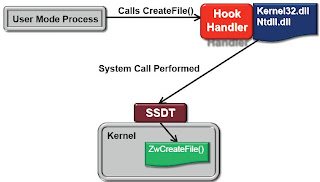Reverse Engineering techniques are generally divided into two broad categories:
1. Static Analysis
2. Dynamic Analysis
1. Static Analysis
2. Dynamic Analysis
Static Analysis
-Techniques which do not involve running the code
-Disassembly, file structure analysis, strings, etc.
Dynamic Analysis
-Techniques which involve running the code
-Behavioral analysis
-Techniques which do not involve running the code
-Disassembly, file structure analysis, strings, etc.
Dynamic Analysis
-Techniques which involve running the code
-Behavioral analysis
Approaches to Dynamic analysis involve:
-Network Monitoring
Isolated Physical Networks
Virtual Networks
-Hardware Emulation
Norman Sandbox, etc.
-Kernel-Level Monitoring (SSDT hooks)
Sysinternal Process Monitor
-Debuggers
-Network Monitoring
Isolated Physical Networks
Virtual Networks
-Hardware Emulation
Norman Sandbox, etc.
-Kernel-Level Monitoring (SSDT hooks)
Sysinternal Process Monitor
-Debuggers
Kernel-Level Monitoring
Advantages
Captures every system call
Can’t be avoided from userland
Disadvantages
Only captures functions implemented as system calls
Not every important function call in the Win32 API is implemented as a system call
Tools don’t differentiate between process housekeeping and calls from usercode
Calls to internal DLL’s cannot be observed
Captures every system call
Can’t be avoided from userland
Disadvantages
Only captures functions implemented as system calls
Not every important function call in the Win32 API is implemented as a system call
Tools don’t differentiate between process housekeeping and calls from usercode
Calls to internal DLL’s cannot be observed
Process Monitoring via Debugging
Advantages
Debugger can trap any function call, not just system calls
Trapped calls are more likely to be highly relevant to the program’s operation
Disadvantages
Have to act as a debugger
Susceptible to countless anti-debugging techniques
Debugger can trap any function call, not just system calls
Trapped calls are more likely to be highly relevant to the program’s operation
Disadvantages
Have to act as a debugger
Susceptible to countless anti-debugging techniques
Inline Hooks
Advantages
Can trap any function call, not just system calls
Trapped calls are more likely to be highly relevant to the program’s operation
Not operating as a debugger
No device driver required
Can trap any function call, not just system calls
Trapped calls are more likely to be highly relevant to the program’s operation
Not operating as a debugger
No device driver required
Disadvantages
Hard to implement
Implementing Inline HooksHard to implement
1. Find a function of interest
2. Disassemble the beginning of the function
3. If possible, overwrite the beginning bytes of the function with a jump or call instruction
4. Implement a handler for the hooked function
2. Disassemble the beginning of the function
3. If possible, overwrite the beginning bytes of the function with a jump or call instruction
4. Implement a handler for the hooked function
What to do with hooked functions?
Observe and Report
Collect data about the current function call by gathering data from stack and report to console
Execute any instructions overwritten from the hook
Jump back to the next instruction in the hooked function
Intercept and Emulate
Perform a specified action instead of calling the intended function
Collect data about the current function call by gathering data from stack and report to console
Execute any instructions overwritten from the hook
Jump back to the next instruction in the hooked function
Intercept and Emulate
Perform a specified action instead of calling the intended function
Running your own Sandbox
-Trap gethostbyname() to always return a fixed IP address.
-A pseudo-handle interface to allow fake reads and writes to files and netwok sockets. Trap connect() to connection to a pseudo-socket. CreateFile(), ReadFile(), WriteFile(), etc.
-A pseudo-handle interface to allow fake reads and writes to files and netwok sockets. Trap connect() to connection to a pseudo-socket. CreateFile(), ReadFile(), WriteFile(), etc.
API Thief Tool (by mandiant.com)
-Launches target process in a suspended state
-Injects a DLL into the process.
-The Injected DLL hooks all Win32 API functions before the target process is resumed
-API Call monitoring can be used simply with a process monitor-style console
-Embedded python can be used to write custom handlers for specific hooked functions
-Injects a DLL into the process.
-The Injected DLL hooks all Win32 API functions before the target process is resumed
-API Call monitoring can be used simply with a process monitor-style console
-Embedded python can be used to write custom handlers for specific hooked functions


